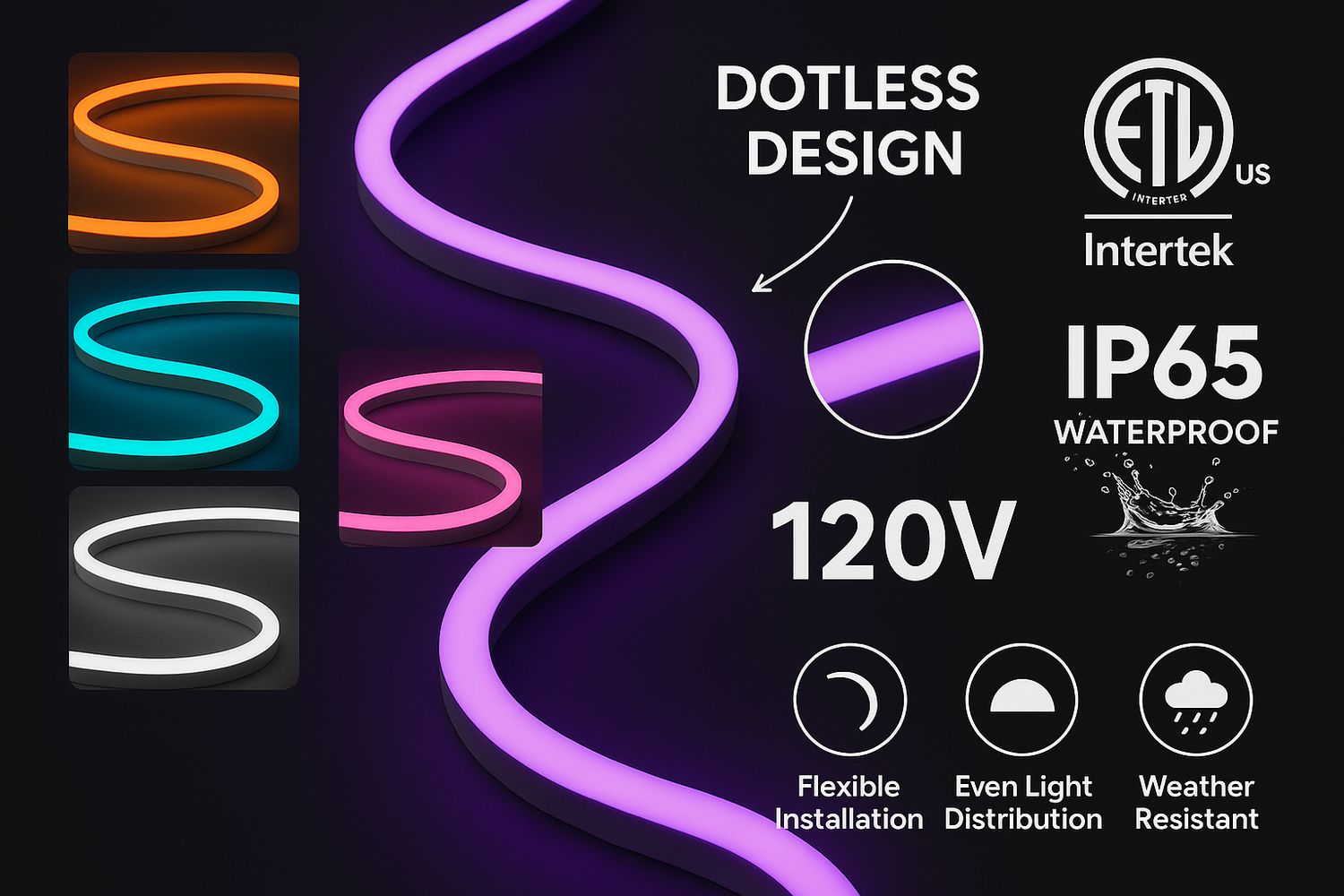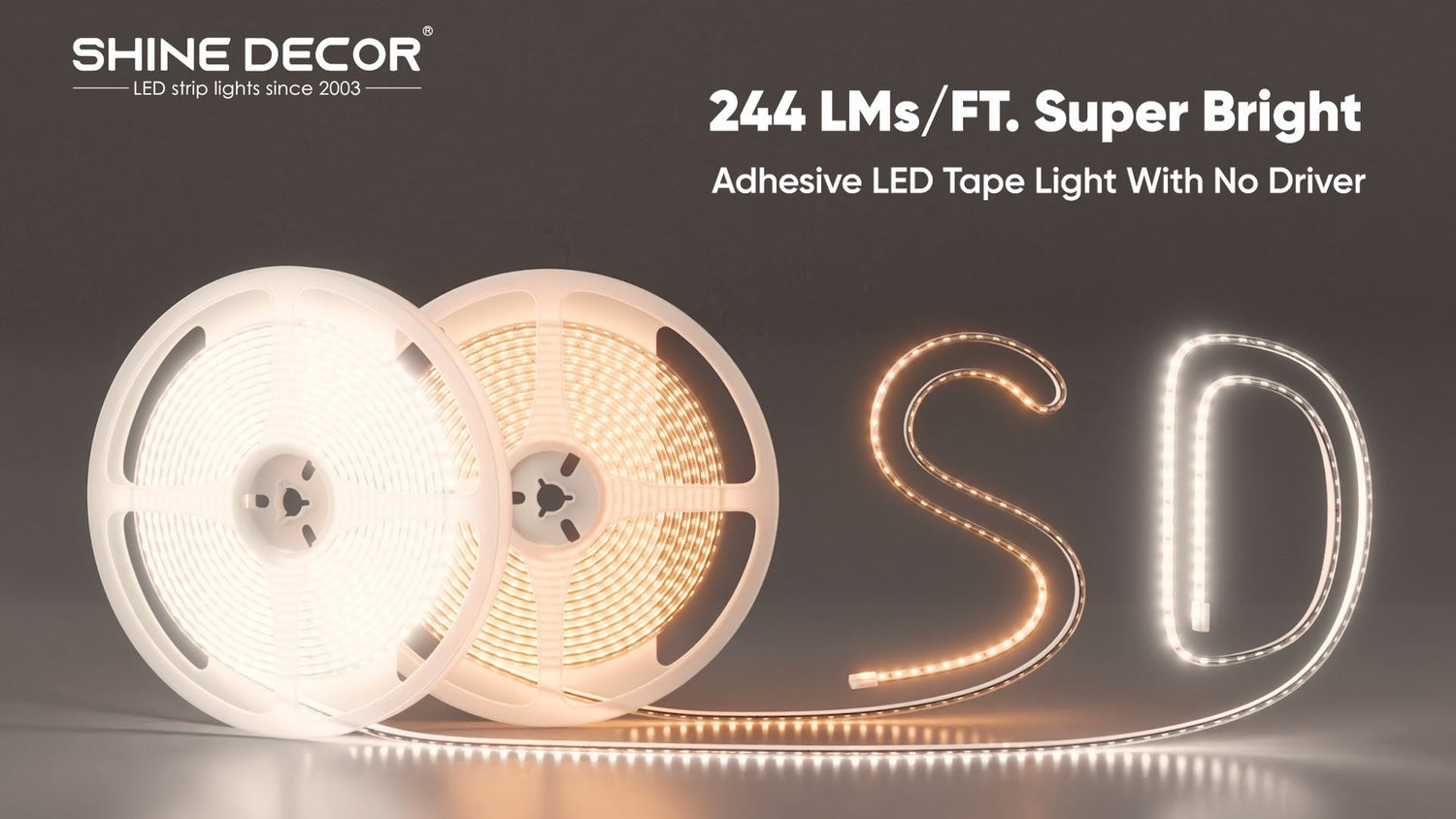
How Long Do LED Rope Lights Live? (Truth Revealed + 7 Expert Tips)
Share
When it comes to energy-efficient lighting, LED neon rope lights have become a popular choice for homeowners, business owners, and designers alike. However, one of the most frequently asked questions is: How long do LED neon rope lights last?
In this comprehensive guide, we’ll explore the average lifespan, factors that affect it, and how you can prolong the life of your lighting investment.

1. Understanding LED Neon Rope Light Technology
What Are LED Neon Rope Lights?
LED neon rope lights are flexible lighting solutions made from durable PVC or silicone housing that encase LED chips. These lights mimic the glow of traditional neon but consume less power, emit less heat, and are safer to operate. Because of their bendable nature and vibrant color options, they’re ideal for everything from signage to ambient lighting.

2. How They Differ From Traditional Neon Lights
Traditional neon lighting relies on gas-filled tubes and high-voltage electrical current to produce light. In contrast, LED neon rope lights use light-emitting diodes (LEDs) powered by low voltage. This makes them:
- Safer (lower heat output)
- More energy-efficient
- Longer-lasting
- Easier to install and maintain

3. Common Applications in Residential and Commercial Settings
You’ll find LED neon rope lights used across a wide range of settings:
- Home decor (under-cabinet lighting, bedrooms)
- Retail displays
- Outdoor architectural lighting
- Event lighting
- Signage and branding
4. Average LED Neon Rope Light Lifespan
Manufacturer Claims vs. Real-World Results
Manufacturers often claim lifespans of 30,000 to 50,000 hours. But in real-life usage, these numbers can vary based on conditions like installation quality and power source.
Let’s break that down:
| Usage Per Day | Expected Lifespan |
|---|---|
| 3 hours/day | Up to 45 years |
| 6 hours/day | Around 20 years |
| 12 hours/day | 10-12 years |
Lifespan in Different Environments (Indoor vs Outdoor)
Outdoor environments expose lights to:
- Rain and humidity.
- Temperature fluctuations.
- Dust and dirt.
Indoor installations tend to last longer due to a controlled climate. Therefore, outdoor lights may only last 70–85% of their rated lifespan unless specifically rated for harsh conditions.

The Role of Usage Hours in Lifespan Expectancy
The more hours the lights are on, the quicker the LED chips will degrade. Even though LEDs don’t “burn out” like traditional bulbs, they dim over time, typically reducing to 70% of their brightness after reaching their rated hours.
5. Factors Affecting LED Neon Rope Light Lifespan
Quality of Manufacturing Components
Not all LED rope lights are created equal. Lights made with high-quality LED chips, UV-resistant housing, and solid-state construction typically last longer and perform more reliably.
Heat Dissipation and Its Impact
Heat is the enemy of LEDs. Poor ventilation or using rope lights in enclosed spaces can trap heat, shortening their lifespan. Always allow for airflow around the lights.
Power Supply and Voltage Stability
Using a regulated power supply ensures the LEDs get a stable current. Voltage spikes can cause irreversible damage to LED circuits.
Installation Techniques and Wiring Best Practices
Improper installation—like using the wrong connectors or bending the rope too tightly—can cause internal wiring issues. Follow manufacturer guidelines and avoid sharp corners or over-stretching.

6. How to Extend the Lifespan of LED Neon Rope Lights
 Choosing High-Quality Products
Choosing High-Quality Products
Invest in rope lights from reputable brands with positive reviews. Look for:
- Certifications like UL, ETL, CE, or RoHS.
- Clear warranty terms.
- IP ratings for waterproof performance.
Proper Installation and Placement
- Avoid installing in direct sunlight unless UV-protected.
- Keep away from high-heat sources (stoves, radiators).
- Use mounting tracks or clips instead of glue to allow heat to escape.
Using Voltage Regulators and Surge Protectors
Protect your lights with voltage regulators and surge protectors, especially if you live in an area with unstable power. This small investment can save your system from early failure.
Routine Cleaning and Maintenance Tips
- Gently wipe down lights using a microfiber cloth.
- Avoid harsh cleaners or water (unless waterproof rated).
- Inspect for cracks or discoloration periodically.
7. Comparative Analysis: LED Neon vs Traditional Neon and Fluorescent Lighting
Lifespan Comparison
| Lighting Type | Average Lifespan |
|---|---|
| LED Neon Rope Lights | 30,000–50,000 hours |
| Traditional Neon | 10,000–15,000 hours |
| Fluorescent Tubes | 7,000–15,000 hours |
LED neon rope lights outperform older lighting options when it comes to longevity.
Energy Efficiency and Cost Benefits Over Time
- LEDs consume up to 80% less energy
- Lower maintenance and replacement costs
- Reduced heat lowers HVAC load, cutting down your utility bill
According to Energy.gov, LED lighting can reduce lighting energy use in homes by up to 75%.

8. Signs Your LED Neon Rope Lights Need Replacement
Dimming or Flickering
One of the first signs that your LED neon rope lights are nearing the end of their life is noticeable dimming. Unlike traditional bulbs that simply burn out, LEDs gradually lose brightness. If you see inconsistent flickering, it could indicate a failing LED chip or a faulty power connection.
Discoloration or Uneven Brightness
If sections of the rope light begin to change color or appear patchy in brightness, it may be due to aging LED chips, poor heat dissipation, or internal damage. This is a strong indicator that a replacement is needed, especially for display or aesthetic applications.
Electrical Issues or Circuit Failures
Tripped breakers, blown fuses, or unusual buzzing sounds can all point to electrical problems within the LED system. These are not only a sign of wear but may also pose safety hazards if not addressed promptly.

9. LED Neon Rope Lights in Harsh Weather Conditions
Waterproof Ratings and What They Mean
For outdoor or wet-area use, LED neon rope lights must carry appropriate IP ratings. Here's a quick breakdown:
| IP Rating | Protection Level |
|---|---|
| IP65 | Protected from water jets |
| IP67 | Can be submerged briefly in water |
| IP68 | Fully submersible for an extended time |
Always choose the correct IP rating based on the environment where the lights will be used.
Performance in Extreme Heat or Cold
Extreme temperatures can shorten the lifespan of rope lights:
- In cold climates, performance may be delayed due to stiffening materials.
- In hot climates, LEDs may overheat, especially if ventilation is poor.
Use temperature-resistant models if your location experiences harsh seasons.
10. Eco-Friendliness and Recycling Considerations
Are LED Neon Rope Lights Recyclable?
Yes, but not in your regular household recycling bin. LED lights contain electronic components and sometimes trace amounts of heavy metals. Proper recycling channels can recover valuable materials like copper and rare earth elements.
Environmental Impact of Disposal
Improper disposal contributes to e-waste, which is harmful to ecosystems. Look for:
- E-waste recycling programs
- Local hazardous waste collection events
- Manufacturers take-back schemes
Being environmentally conscious adds value to your lighting upgrade.

11. Cost-Benefit Analysis of Shine Decor Long-Lasting LED Neon Rope Lights
Initial Investment vs. Replacement Costs
LED neon rope lights may cost more upfront than traditional lighting, but their longer lifespan and lower energy usage make them more cost-effective over time.

| Cost Category | Traditional Neon | LED Neon |
|---|---|---|
| Initial Cost | Lower | Higher |
| Maintenance | Frequent | Minimal |
| Energy Use (annually) | High | Low |
| Total Lifetime Cost | Higher | Lower |
ROI in Commercial Lighting Projects
Businesses that invest in LED neon rope lighting can expect a return on investment (ROI) within 1–2 years, thanks to:
- Lower electricity bills
- Reduced replacement costs
- Better visual appeal leads to higher customer engagement
12. FAQs About LED Neon Rope Light Lifespan
1. Can LED neon rope lights burn out suddenly?
Unlike incandescent bulbs, LEDs don't burn out suddenly. They gradually dim over time. However, poor installation or power surges can cause premature failure.
2. Do LED neon lights lose brightness over time?
Yes. Most LEDs maintain brightness for 30,000–50,000 hours but will slowly dim, typically to 70% of their original brightness after full lifespan.
3. How can I tell if my LED rope lights are dying?
Watch for flickering, dimming, color shifting, or dead spots. These are indicators that your lights are aging or experiencing power issues.
4. Is it okay to cut LED neon rope lights?
Yes, but only at designated cut points marked by the manufacturer. Cutting elsewhere can damage the circuit and void the warranty.
5. Can I leave LED rope lights on 24/7?
Technically, yes, but it may reduce their lifespan. It’s best to use timers or motion sensors to manage usage and preserve longevity.
6. What’s the best way to protect outdoor LED rope lights?
Use weatherproof models with high IP ratings and install them with proper mounting hardware to keep them secure and ventilated.
13. Conclusion: Making the Most of Your LED Neon Rope Lighting
LED neon rope lights are a game-changer in modern lighting design. With an impressive lifespan of 30,000 to 50,000 hours, they offer both style and sustainability. By choosing quality products, installing them properly, and performing routine maintenance, you can maximize your investment and enjoy vibrant, energy-efficient lighting for years.

Whether you're lighting up a cozy living room or creating an eye-catching storefront, understanding the lifespan of your LED neon rope lights—and how to extend it—can make all the difference.
So go ahead—light it up smartly and sustainably!




